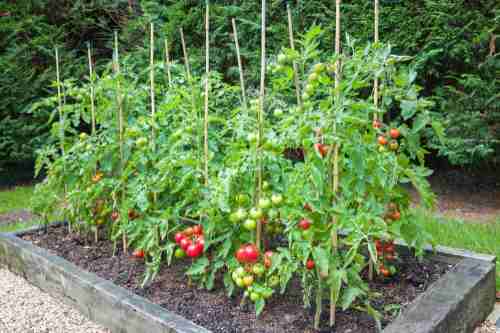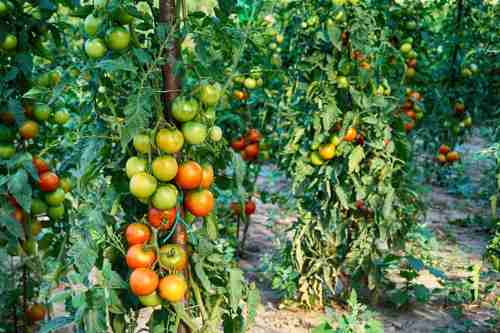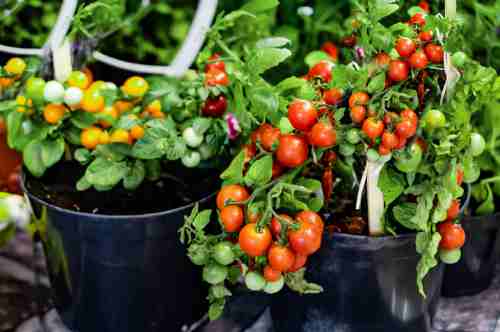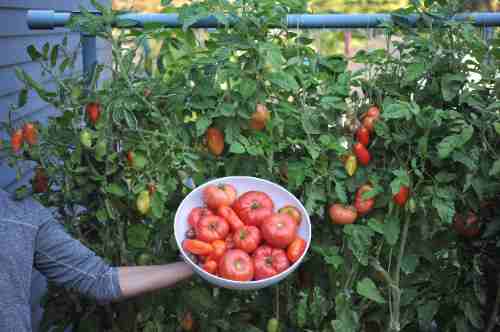A tomato plant that is spaced correctly is likely to grow healthier and yield greater yields than those that are overcrowded or dispersed. The spacing of tomatoes is determined by two aspects: what kinds of tomatoes you’re planting and how you intend to help the plant. Once you’ve gathered those essential details, deciding how far to grow tomatoes is simple.

What distance should you grow tomatoes?
There are four primary reasons why you should aim to have well-located tomato plants:
Prevention of diseases. The tomato plant is vulnerable to many illnesses, and when placed too close together, insufficient air circulation can raise the likelihood of infection.
Adequate light. The tomato plants that love heat require plenty of sun to grow healthy. If you plant seedlings in a crowded area with plants, they’ll cast shadows over their neighbours as they expand.
Production. I love to use every inch of my garden, leaving a small amount of soil open to allow weeds to flourish. If you space tomatoes out, too much leaves room for growing weeds, saving valuable space for growing and lessening your potential harvest.
A lesser amount of competition. As we said, the airflow is reduced in congested plants, which signifies that plants compete for nutrients and water.

Why Tomatoes Need the Right Amount of Space
The tomato needs some space to permit better airflow that helps to keep their leaves dry and reduce chances of developing fungal or bacterial infections, according to Dr Clydette Alsup-Egbers, associate professor of the Department of environmental plant science at Missouri State University. According to her, it is recommended to plant them at a distance of at least two feet.
According to Autumn Hilliard-Knapp, if you’re growing many tomatoes this season, it’s important to ensure the rows are separated. She is the horticulture specialist at Perfect Plants Nursery. Each row needs to be at least two feet from the next one. “This is another way to allow for good sun and air circulation to every plant, and keep diseases at bay and ensure a healthy productivity or growth,” she says.
Growing tomato plants in the gardens

“Appropriate spacing will allow for greater circulation of air and better exposure to sunlight, helping to regulate moisture and photosynthesis,” says Hillard-Knapp. “Having sufficient space to allow each plant to get a precise amount of sunlight can help the tomato plant to flourish. In addition, proper spacing improves soil fertility because every plant has enough space to get the nutrients it needs from the soil around it.”
Disease and Pest Prevention
Although proper spacing doesn’t assure a pest-free crop however it does help in reducing the spread of insects. “If the plants are properly spaced, they are less likely that pests on one particular plant will propagate to the other crops,” says Hillard-Knapp. Common tomato plant diseases include early blight, root rot, black mould, and early blight. The expert says they thrive in humid environments and are often present in tomato plants that are planted too closely to the plant.
Spacing by Tomato Type

Although the length of time required for growing is different for each variety of tomato, according to Hilliard-Knapp, the two main elements in determining the amount of space you’ll need are based on the indeterminate or determinate type of tomato.
Determinate Tomatoes
“A determinate tomato plant can yield fruit if planted at least 2 feet apart,” says Hilliard-Knapp, because determinate tomatoes need lesser space because they grow only until a certain amount before halting.
Indeterminate Tomatoes
A determinate requires a larger space. “An undetermined tomato plant would thrive if planted within 3-4 feet apart,” she says. “This is because indeterminate tomatoes grow forever and continue to bloom and bear fruit.”
Harvesting and Storing Tips
- Let’s get to the fun part of picking and eating the tomatoes! If it’s time to harvest your tomatoes, here are some ideas to be aware of:
- Place your tomatoes on the plants until the fruit changes colour, mostly to the final shade, which could be orange, red or purple.
Pull up gently on the fruit to keep it from the plant instead of dragging it down on the fruit, which could damage the branch.
If you notice that animals or birds devour tomatoes before you can pick they are, or when the threat of frost is imminent, take tomatoes that haven’t yet begun to turn colour, and then you can bring them inside the form of a bag made from paper.
The tomatoes shouldn’t be stored in refrigerators as it deteriorates the taste and texture of fresh garden fruit.
Freezing tomatoes is an excellent method to keep them in good condition. It is also possible to make your tomatoes in a canned sauce.